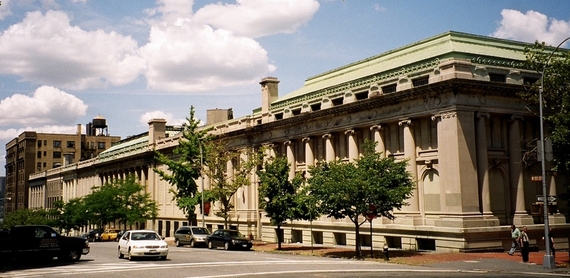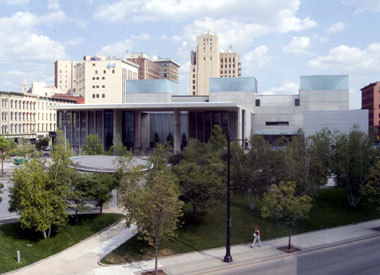This afternoon I visited Grand Rapid's beautiful art museum (GRAM) for their yearly student art exhibition, Art/Prize and though I arrived somewhat frazzled, I left in a state of deep contentment.
That's not surprising. I love museums. My parents often took me to The Metropolitan Museum of Art in New York and the Museum of Modern Art when I was in elementary school. And though I was raised in a household of angry Holocaust survivors I grew up just a few blocks from an extraordinary complex of museums in upper Manhattan on Audubon terrace. These Beaux Arts buildings housed the American Indian Museum, The Hispanic Society Museum, The American Numismatic Society and The American Geographic Society, along with other organizations.
There was sculpture in the courtyard between the twin ranks of buildings and the quiet grace and beauty of the complex offered a haven, as well as a deeper entrance into the glamorous style of the Gilded Age that I already admired without knowing what it was. I would find out years later that I lived in an elegant 1903 apartment building and borrowed books weekly from a Stanford White-designed public library.
I didn't just enter the buildings on Audubon Terrace, I passed them hundreds of times growing up--they were the comforting backdrop of my childhood.
![2014-10-02-AudubonTerraceRear.jpg]()
But in Grand Rapids, my GPS seemed to have HAL in 2001: a Space Odyssey as its role model and so I drove confusedly along unfamiliar streets past swirling crowds. I actually needed someone at the museum to guide me over the phone to a parking structure that wasn't full. Truly Old School.
![2014-10-02-1gram.jpg]()
So I arrived at GRAM feeling surly and put-upon, but within moments, I was transformed. Moving slowly and quietly from one floor to another, entering different worlds evoked by artists I didn't know but whose work I quickly felt drawn to, my having been lost melted away.
Not everything spoke to me, and I didn't expect it to. But when something did, even the people around me blurred and seemed unreal, their voices coming as from a distance, because the art I was pulled into was that alive and powerful. As a writer, I think I look for art that either tells a story or makes me tell a story, makes me invent meaning, play a game sometimes, or find my way out of the Minotaur's maze before it's too late.
I didn't read Anila Agha's explanation of her hypnotic "Intersections" until I got home because I was happy to let it tell me a story of my own making. Hung from the ceiling, the giant black, lacy, laser-cut cube with one light bulb inside projected shadows on the floor, walls, ceiling and the people who walked around it. I found it exhilarating, simple and complex, open and closed. I loved all of that, but couldn't quite capture it on film, so a shadow will have to do.
![2014-10-02-DSC01025.JPG]()
Marshall K. Harris's "The burden of honoring one's father" was much starker and more disturbing, and I could sense people both drawn to it and repelled. I waited patiently for a space to clear in front of it so I could study it in alone, for a few moments, at least. I was thinking of how my father still had the ability to push my buttons. He had, after all, installed them, and a conversation of the last 24 hours had left me feeling almost as raw as the wood in Harris's stark, compelling painting. And yes, left me hanging because nothing I could say would ever change him.
![2014-10-02-DSC01038.JPG]()
Liz Roberts "Always Nowhere" was a car with films of roads whizzing by playing on each window and I immediately though of The Talking Heads "Road to Nowhere," though that song is mellow and the more I looked at Roberts' car, the more menacing it was. Everything was sealed, nothing could be seen. And how many trips do we take like that where motion is all that matters or even registers? I wondered if Roberts had actually put something inside.... The idea appealed to me.
![2014-10-02-DSC01033.JPG]()
Danielle Owensby's work charts different aspects of growing up in a house that seemed in perpetual upheaval, constantly being rebuilt and never finished. It was a neighborhood eyesore and topic of discussion. In the midst of this chaos, she poses herself at various times with the ironic serenity of Marina Abramovic amid carefully composed scenes of drenched color and mysterious beauty, finding order in the quotidian. Here's one of the eight marvelous photographs:
![2014-10-02-DSC01030.JPG]()
The drive back happily couldn't have been simpler, and reflecting on these artists and the whole experience, I thought of Henry James's famous lines in a letter to H.G. Wells: "It is art that makes life, makes interest, makes importance...and I know of no substitute whatever for the force and beauty of its process.
This blog is dedicated to all the students at MSU who have inspired me.
That's not surprising. I love museums. My parents often took me to The Metropolitan Museum of Art in New York and the Museum of Modern Art when I was in elementary school. And though I was raised in a household of angry Holocaust survivors I grew up just a few blocks from an extraordinary complex of museums in upper Manhattan on Audubon terrace. These Beaux Arts buildings housed the American Indian Museum, The Hispanic Society Museum, The American Numismatic Society and The American Geographic Society, along with other organizations.
There was sculpture in the courtyard between the twin ranks of buildings and the quiet grace and beauty of the complex offered a haven, as well as a deeper entrance into the glamorous style of the Gilded Age that I already admired without knowing what it was. I would find out years later that I lived in an elegant 1903 apartment building and borrowed books weekly from a Stanford White-designed public library.
I didn't just enter the buildings on Audubon Terrace, I passed them hundreds of times growing up--they were the comforting backdrop of my childhood.

But in Grand Rapids, my GPS seemed to have HAL in 2001: a Space Odyssey as its role model and so I drove confusedly along unfamiliar streets past swirling crowds. I actually needed someone at the museum to guide me over the phone to a parking structure that wasn't full. Truly Old School.

So I arrived at GRAM feeling surly and put-upon, but within moments, I was transformed. Moving slowly and quietly from one floor to another, entering different worlds evoked by artists I didn't know but whose work I quickly felt drawn to, my having been lost melted away.
Not everything spoke to me, and I didn't expect it to. But when something did, even the people around me blurred and seemed unreal, their voices coming as from a distance, because the art I was pulled into was that alive and powerful. As a writer, I think I look for art that either tells a story or makes me tell a story, makes me invent meaning, play a game sometimes, or find my way out of the Minotaur's maze before it's too late.
I didn't read Anila Agha's explanation of her hypnotic "Intersections" until I got home because I was happy to let it tell me a story of my own making. Hung from the ceiling, the giant black, lacy, laser-cut cube with one light bulb inside projected shadows on the floor, walls, ceiling and the people who walked around it. I found it exhilarating, simple and complex, open and closed. I loved all of that, but couldn't quite capture it on film, so a shadow will have to do.
Marshall K. Harris's "The burden of honoring one's father" was much starker and more disturbing, and I could sense people both drawn to it and repelled. I waited patiently for a space to clear in front of it so I could study it in alone, for a few moments, at least. I was thinking of how my father still had the ability to push my buttons. He had, after all, installed them, and a conversation of the last 24 hours had left me feeling almost as raw as the wood in Harris's stark, compelling painting. And yes, left me hanging because nothing I could say would ever change him.
Liz Roberts "Always Nowhere" was a car with films of roads whizzing by playing on each window and I immediately though of The Talking Heads "Road to Nowhere," though that song is mellow and the more I looked at Roberts' car, the more menacing it was. Everything was sealed, nothing could be seen. And how many trips do we take like that where motion is all that matters or even registers? I wondered if Roberts had actually put something inside.... The idea appealed to me.
Danielle Owensby's work charts different aspects of growing up in a house that seemed in perpetual upheaval, constantly being rebuilt and never finished. It was a neighborhood eyesore and topic of discussion. In the midst of this chaos, she poses herself at various times with the ironic serenity of Marina Abramovic amid carefully composed scenes of drenched color and mysterious beauty, finding order in the quotidian. Here's one of the eight marvelous photographs:
The drive back happily couldn't have been simpler, and reflecting on these artists and the whole experience, I thought of Henry James's famous lines in a letter to H.G. Wells: "It is art that makes life, makes interest, makes importance...and I know of no substitute whatever for the force and beauty of its process.
This blog is dedicated to all the students at MSU who have inspired me.